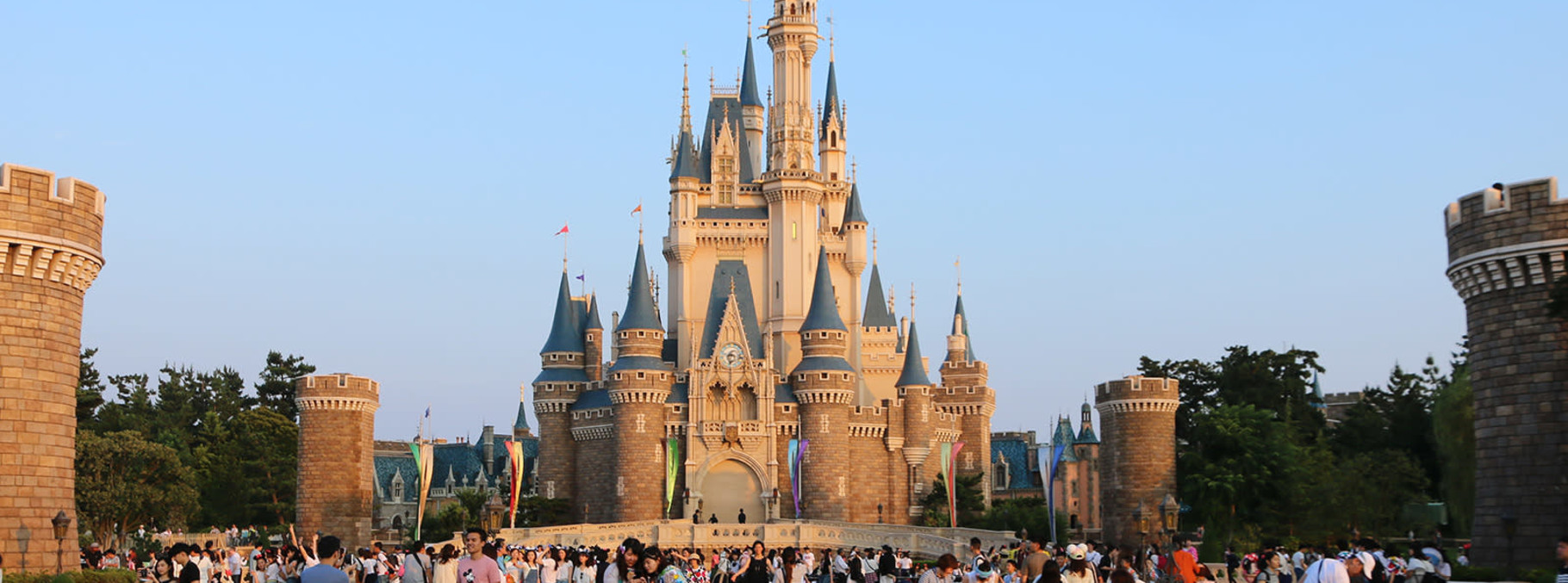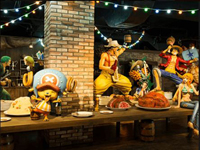Itsukushima Jinja
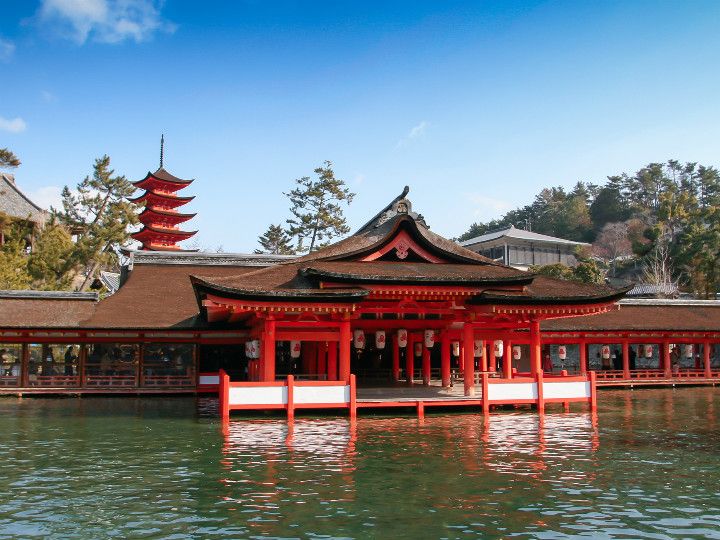
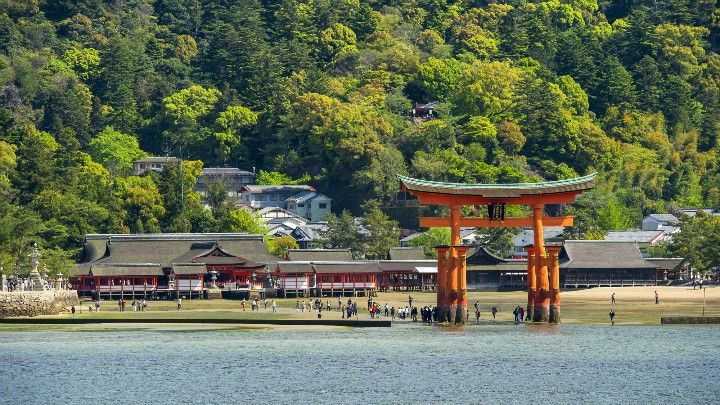
(Source: BASICO / PIXTA(ピクスタ) )
Big torii rendering different looks at high tide and low tide
The first thing that comes into view, as you approach Miyajima Island on a ferry, is the famous big torii of Itsukushima Jinja. The pillars of this 16-meter-tall torii are not fixed to the ground but rather their weights enable the entire structure to stand on the water. The torii looks absolutely fascinating “floating” during high tide but at low tide, the water ebbs away to the point which allows you to walk up to the base of the pillars.
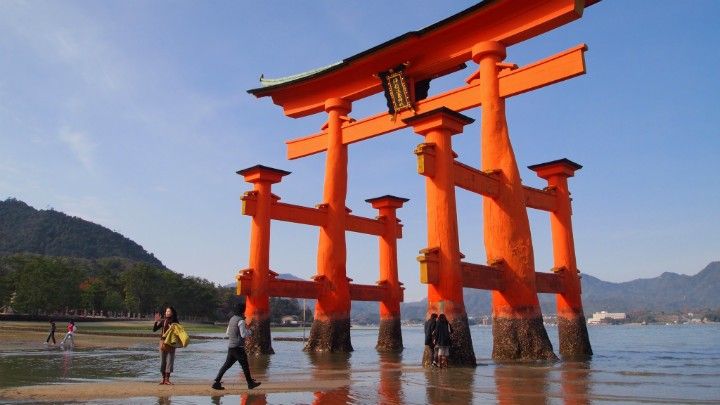
(Source: 御朱印巡り)
Sculls and Paddles Boats & Houseboats
Big torii is also accessible by boat. There are two kinds of boats in operation: during the daytime runs rokaibune, a long and narrow boat operated with sculls and paddles, while at the nighttime runs yakatabune, a boat with a roof. The shrine’s big torii and the main hall, both illuminated at night, offer a different appearance from daytime with the quality of other-worldliness.
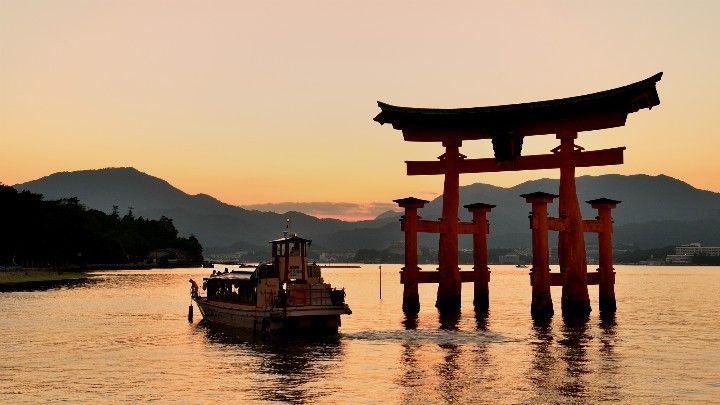
(Source: s_fukumura / PIXTA(ピクスタ))
Main Hall
The Main Hall, with a majestic aura, enshrines three goddesses. The shrine is said to be capable of bestowing divine protection for the worshippers from accidents on the road and the sea and bringing success in wars and competitions, thus prompting many historical military commanders and emperors to pay visits. It was reconstructed to have its current appearance in 1571.
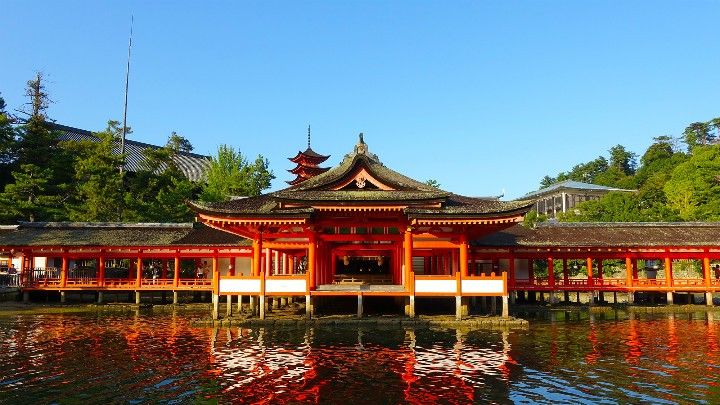
(Source: TOMOCHIN BLOG)
Hirabutai and Takabutai
Hirabutai, a plain stage, serves like a garden for Itsukushima Jinja standing over the water and Takabutai, an elevated stage, was created as a space for Japanese ancient dance. The plain stage has a very sturdy structure supported by 239 pillars. Standing on the plain stage and looking out at the Main Hall over the elevated stage provides a view reminiscent of ancient Japan.
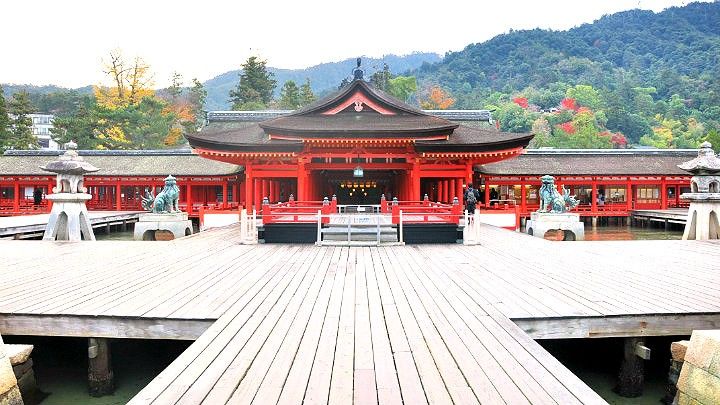
(Source: 犬島アートプロジェクト精錬所と平清盛の厳島)
Corridor
From the Main Hall stretch both the West Corridor and East Corridor. A vermillion corridor extending long and straight makes a perfect composition for photographs. There is a slight gap between each floor board of the corridors. This is to disperse the force of surging waves, an ingenuity of a structure like Itsukushima Jinja which was built on the water.
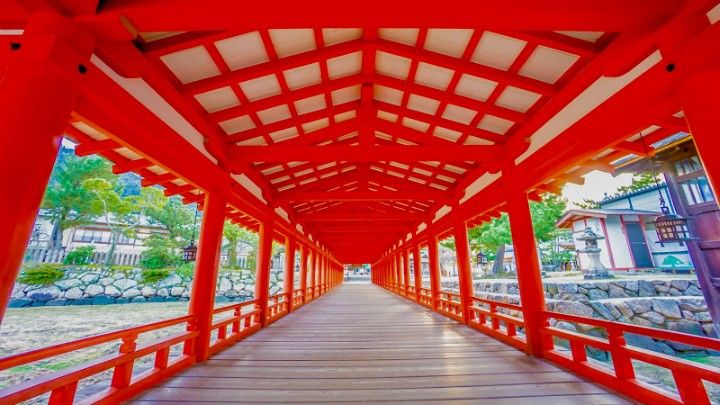
(Source: kosublog)
Noh Stage
Noh Stage was specifically designed as a space for Noh, a traditional Japanese masked drama with dance and song. Noh Stage at Itsukushima Jinja is one of a kind in that it is set above the sea. It is a building of historical importance and value of about 400 years old and since the 1500s, there has been dancing dedicated to the shrine.
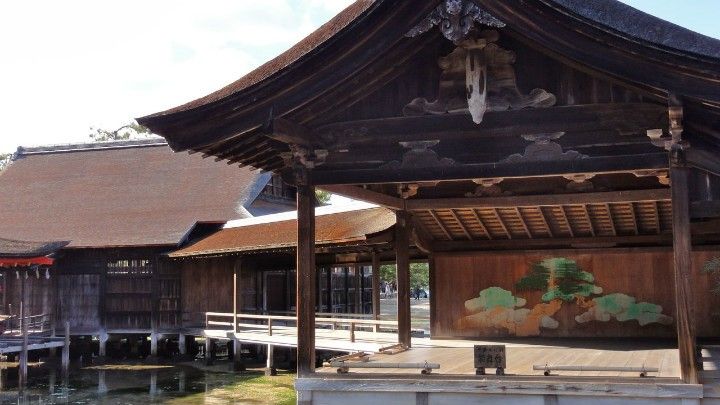
(Source: SUNQBABAブログ)
Soribashi, a bending bridge
Soribashi, literally bending bridge, which connects the West Corridor to the island’s terrain was used by imperial envoys during visitations. The current structure came into existence in 1557 and when viewing the bridge from inside the Main Hall, you will see the beautiful contrast of vermillion against the island’s gorgeous green.
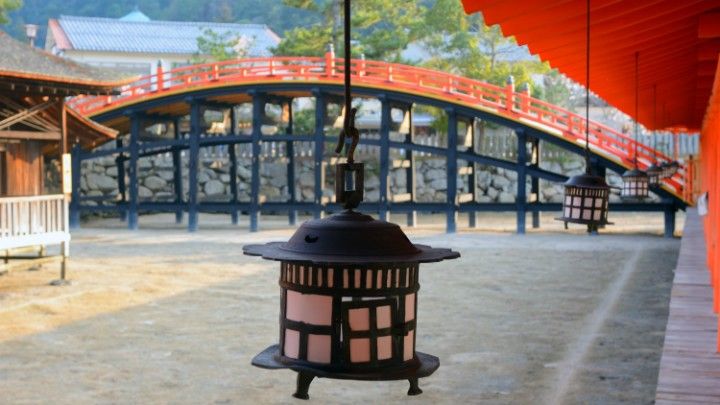
(Source: Attila JANDI/shutterstock)
Wild deer inhabiting the area surrounding Itsukushima Jinja
Numerous wild deer inhabit Miyajima Island in the area surrounding Itsukushima Jinja. These deer are descendants of the group acquired from Nara Park in Nara Prefecture. The deer in Nara Park are regarded as messengers of the deity of Kasuga Taisha Shrine, thus inevitably making deer in Miyajima Island equally highly-regarded. Please note, however, that feeding them is prohibited on the island.
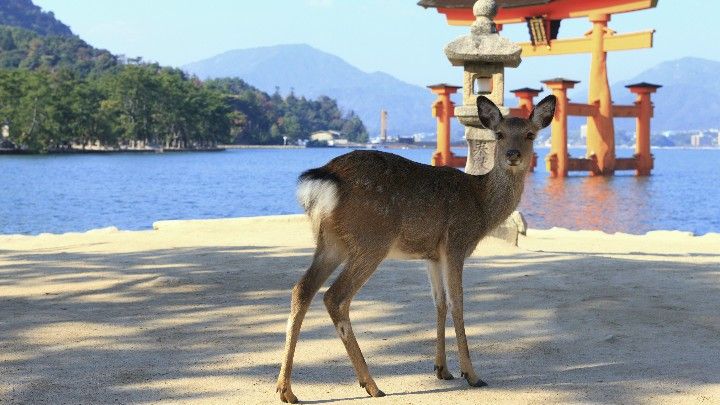
(Source: KPG_Payless/shutterstock)
Omotesando Shopping Street
Between the ferry stop and Itsukushima Jinja lies a strip of Omotesando Shopping Street. The Street is lined by 70 or so merchants and eateries serving Miyajima Island’s famous oysters, sweets, souvenir items and so on. One of the most popular vendors is Okino Suisan, an oyster farmer, who has the freshest and yet reasonably-priced oysters.
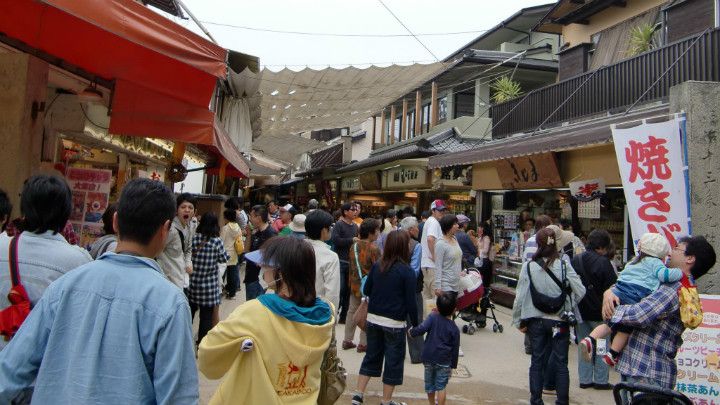
(Source: ミサイルマシンのブログ)
Buns in the shape of a maple leaf, a specialty of Miyajima Island
The item known nationwide as one of the specialties of Miyajima Island is Momiji Manju, a bun shaped like a maple leaf. In the shopping street, there are many bakeries who make them, including Iwamura Momijiya, an old establishment that has been in business since the Meiji era. Some bakeries produce eclectic types experimenting with cheese, curry or chocolate flavor, in addition to the most traditional one with red bean paste inside.
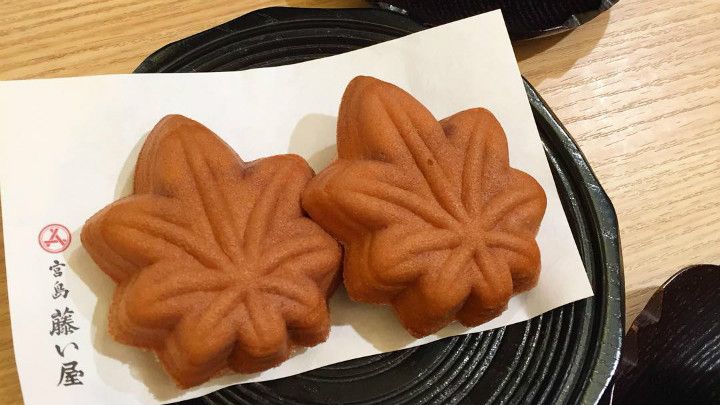
(Source: Instagram)

(Source: BASICO / PIXTA(ピクスタ) )
Big torii rendering different looks at high tide and low tide
The first thing that comes into view, as you approach Miyajima Island on a ferry, is the famous big torii of Itsukushima Jinja. The pillars of this 16-meter-tall torii are not fixed to the ground but rather their weights enable the entire structure to stand on the water. The torii looks absolutely fascinating “floating” during high tide but at low tide, the water ebbs away to the point which allows you to walk up to the base of the pillars.

(Source: 御朱印巡り)
Sculls and Paddles Boats & Houseboats
Big torii is also accessible by boat. There are two kinds of boats in operation: during the daytime runs rokaibune, a long and narrow boat operated with sculls and paddles, while at the nighttime runs yakatabune, a boat with a roof. The shrine’s big torii and the main hall, both illuminated at night, offer a different appearance from daytime with the quality of other-worldliness.

(Source: s_fukumura / PIXTA(ピクスタ))
Main Hall
The Main Hall, with a majestic aura, enshrines three goddesses. The shrine is said to be capable of bestowing divine protection for the worshippers from accidents on the road and the sea and bringing success in wars and competitions, thus prompting many historical military commanders and emperors to pay visits. It was reconstructed to have its current appearance in 1571.

(Source: TOMOCHIN BLOG)
Hirabutai and Takabutai
Hirabutai, a plain stage, serves like a garden for Itsukushima Jinja standing over the water and Takabutai, an elevated stage, was created as a space for Japanese ancient dance. The plain stage has a very sturdy structure supported by 239 pillars. Standing on the plain stage and looking out at the Main Hall over the elevated stage provides a view reminiscent of ancient Japan.

(Source: 犬島アートプロジェクト精錬所と平清盛の厳島)
Corridor
From the Main Hall stretch both the West Corridor and East Corridor. A vermillion corridor extending long and straight makes a perfect composition for photographs. There is a slight gap between each floor board of the corridors. This is to disperse the force of surging waves, an ingenuity of a structure like Itsukushima Jinja which was built on the water.

(Source: kosublog)
Noh Stage
Noh Stage was specifically designed as a space for Noh, a traditional Japanese masked drama with dance and song. Noh Stage at Itsukushima Jinja is one of a kind in that it is set above the sea. It is a building of historical importance and value of about 400 years old and since the 1500s, there has been dancing dedicated to the shrine.

(Source: SUNQBABAブログ)
Soribashi, a bending bridge
Soribashi, literally bending bridge, which connects the West Corridor to the island’s terrain was used by imperial envoys during visitations. The current structure came into existence in 1557 and when viewing the bridge from inside the Main Hall, you will see the beautiful contrast of vermillion against the island’s gorgeous green.

(Source: Attila JANDI/shutterstock)
Wild deer inhabiting the area surrounding Itsukushima Jinja
Numerous wild deer inhabit Miyajima Island in the area surrounding Itsukushima Jinja. These deer are descendants of the group acquired from Nara Park in Nara Prefecture. The deer in Nara Park are regarded as messengers of the deity of Kasuga Taisha Shrine, thus inevitably making deer in Miyajima Island equally highly-regarded. Please note, however, that feeding them is prohibited on the island.

(Source: KPG_Payless/shutterstock)
Omotesando Shopping Street
Between the ferry stop and Itsukushima Jinja lies a strip of Omotesando Shopping Street. The Street is lined by 70 or so merchants and eateries serving Miyajima Island’s famous oysters, sweets, souvenir items and so on. One of the most popular vendors is Okino Suisan, an oyster farmer, who has the freshest and yet reasonably-priced oysters.

(Source: ミサイルマシンのブログ)
Buns in the shape of a maple leaf, a specialty of Miyajima Island
The item known nationwide as one of the specialties of Miyajima Island is Momiji Manju, a bun shaped like a maple leaf. In the shopping street, there are many bakeries who make them, including Iwamura Momijiya, an old establishment that has been in business since the Meiji era. Some bakeries produce eclectic types experimenting with cheese, curry or chocolate flavor, in addition to the most traditional one with red bean paste inside.

(Source: Instagram)




